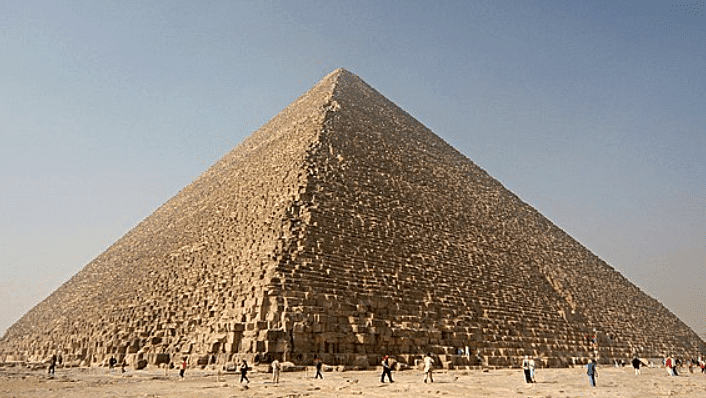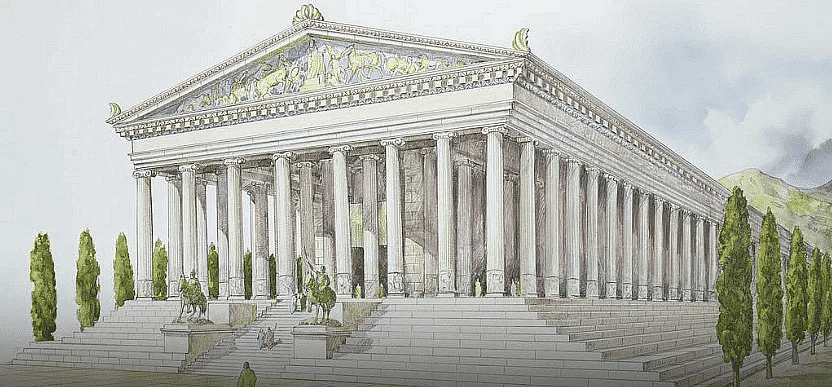Seven Wonders of the Ancient World | Famous Books for UPSC Exam (Summary & Tests) PDF Download
| Table of contents |

|
| Great Pyramid of Giza, Egypt |

|
| Hanging Gardens of Babylon |

|
| Statue of Zeus at Olympia |

|
| Temple of Artemis at Ephesus |

|
| Mausoleum at Halicarnassus |

|
| Colossus of Rhodes |

|
| Lighthouse of Alexandria |

|
Great Pyramid of Giza, Egypt
The Great Pyramid of Giza, located on the west bank of the Nile River north of Cairo, Egypt, stands as the sole surviving wonder of the ancient world. It forms part of a trio of majestic pyramids – Khufu (Cheops), Khafra (Chephren), and Menkaura (Mycerinus) – constructed as royal tombs between 2700 B.C. and 2500 B.C. The most impressive of these is Khufu, known as "The Great Pyramid," sprawling over 13 acres and composed of over 2 million stone blocks, weighing between two to thirty tons each. A remarkable fact: the Great Pyramid held the title of the world's tallest building for over 4,000 years, a record unmatched until the 19th century. Mysteriously, these ancient wonders were built without the aid of modern tools and technology, leaving historians in awe of the ingenuity of ancient Egyptian architects and builders.
Hanging Gardens of Babylon
According to ancient Greek poets, the Hanging Gardens of Babylon were a botanical marvel, said to have been created by King Nebuchadnezzar II in the 6th century B.C. Located near the Euphrates River in present-day Iraq, the gardens were a testament to the king's devotion to his wife, Amytis, who longed for the lush beauty of her homeland in Media (modern-day Iran). The gardens were reportedly suspended in the air on a massive square brick terrace, providing a breathtaking sight of flora arranged like an ascending theater. Modern-day scholars, however, speculate that this wonder might have been a product of myth and legend, as no direct evidence of its existence has been found.
Statue of Zeus at Olympia
Crafted by the renowned Athenian sculptor Phidias in the mid-5th century B.C., the Statue of Zeus at Olympia stood majestically in the temple of Zeus at Olympia, the site of the ancient Olympics. Depicting the Greek god of thunder, Zeus, seated on a wooden throne, the statue measured an astonishing 40 feet in height, with intricate details adorned in gold and ivory. A tale surrounding its creation tells of Phidias receiving a divine sign of approval from Zeus himself through a lightning strike that hit the temple. Despite its grandeur, the statue met its end in the 4th century A.D. when Christian priests convinced the Roman emperor to close the temple, and it is believed to have been destroyed in a fire in 462.
Temple of Artemis at Ephesus
Mausoleum at Halicarnassus
In what is now southeastern Turkey, the Mausoleum at Halicarnassus was a solemn tribute built by Queen Artemisia for her husband and brother, Mausolus, the king of Carnia, who passed away in 353 B.C. The grand mausoleum, reaching approximately 135 feet in height, exhibited a fusion of Lycian, Greek, and Egyptian architectural styles. Comprising three rectangular layers adorned with elaborate sculptures, the mausoleum's pinnacle displayed a stunning four-horse chariot sculpture. Despite enduring centuries, earthquakes eventually ravaged the structure, with remnants incorporated into a nearby castle's fortification.
Colossus of Rhodes
The Colossus of Rhodes, an awe-inspiring bronze statue dedicated to the sun god Helios, graced the city of Rhodes in the 3rd century B.C. Designed by sculptor Chares and standing at an impressive 100 feet tall, it was the tallest ancient wonder. The Rhodians reportedly used the remnants of equipment left behind by a Macedonian siege to fund the statue's construction. Unfortunately, it stood for only six decades before an earthquake toppled it. Arab invaders later sold the remains for scrap metal, leaving the world to imagine the striking image of the sun god holding a torch and spear.
Lighthouse of Alexandria

Rising from the small island of Pharos near Alexandria, Egypt, the Lighthouse of Alexandria was a marvel of maritime navigation, guiding ships in and out of the bustling harbor during the reign of Ptolemy II in 270 B.C. Thought to have been around 380 feet tall, it consisted of three tiers: a square base, an octagonal middle section, and a cylindrical top, crowned with a 16-foot statue, possibly of Ptolemy II or Alexander the Great. Unfortunately, earthquakes in the following centuries took their toll on the lighthouse, and its remains lie submerged beneath the Nile.
|
743 videos|1444 docs|633 tests
|

















